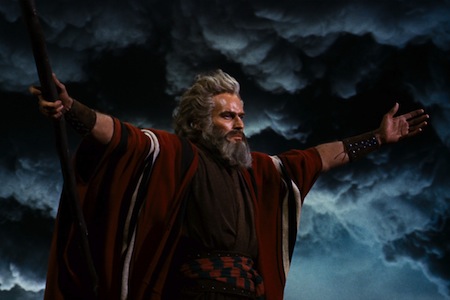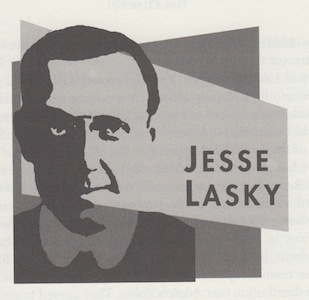Born: September 30, 1880, San Francisco, CA
Died: January 13, 1958, Beverly Hills, CA
At that time, Hollywood had just one policeman, and he generally stood at the corner of Hollywood and Vine.
—Jesse Lasky
By 1913, the film industry had a solid group of quality studios turning out movies at a regular clip. In fact, most of the motion picture business was controlled by large companies, principally Biograph, Vitagraph, Essanay and Lubin. To break into moviemaking, a young producer like Jesse Lasky had two choices: he could join a studio and do it their way, or he could head out on his own. Lasky was among a new batch of filmmakers who became “independent” producers—those who made movies with whatever equipment they could afford and distributed them directly to theater owners. It was these “indies” that Thomas Edison’s aggressive organization, the Motion Pictures Patents Company, was determined to drive out of business. At first, Lasky refused to buckle under the pressure, but when Edison sent goons to physically threaten him, Lasky packed his entire company and headed for California to an inconspicuous, undeveloped town called Hollywood.
Setting up shop in a small office on Sunset Boulevard in Los Angeles, Lasky became the founder of a new industrial mecca, the center of world film production for the next eighty years, and a good distance from the Trust thugs who threatened his small studio. Lasky simply couldn’t afford to let Edison present huge problems for his biggest production, the historical Squaw Man (1914). The first film to be made in Los Angeles, it featured the talents of director Cecil B. DeMille.
DeMille and Lasky discovered that Hollywood was an ideal place to make movies. First of all, it was equidistant from ocean vistas, mountainous terrain and stark deserts—and not very distant, at that; almost any location or climate could be simulated within a few hours of the Sunset Strip. Initially, the citizens of the town didn’t appreciate the influx of “movies,” a derogatory term for the hoards of rodeo riders, circus performers and thespians who found work there. But soon other studios followed Lasky to Southern California, staked out their lots and began building their movie empires.
Lasky, helming his newly formed Feature Play Company, was now safely making movies in Hollywood, and with backing from his brother-in-law, Samuel Goldwyn, business was taking off. To ensure that his films would be exhibited, he teamed up with W.W. Hodkinson in 1916 and discussed a merger with distribution czar Adolph Zukor. They agreed to combine Zukor’s Famous Players Film Company with Lasky’s Feature Play Company and, after several name changes, eventually called the joint venture Paramount Corporation after another small company they had folded into the acquisition.
Instantly, Paramount became a major studio and Hollywood became a boom town. Lasky and Zukor paid lucrative fees to lure established stars such as Mary Pickford, Fatty Arbuckle, Gloria Swanson and Rudolph Valentino to California and paid their handsome salaries by charging theater owners a premium to display their films. Then, they actively discovered or stole nearly all of the emerging stars of the twenties and thirties, including Carole Lombard, Marlene Dietrich, Mae West and Gary Cooper. Directors of the stature of Ernst Lubitsch and Rouben Mamoulian were plucked out of Europe, and promising writers, including Preston Sturges and Billy Wilder, were later groomed for directorship in the family atmosphere of Paramount. Lasky also had a keen sense for innovators in peripheral areas; he gave career breaks to documentarian Robert Flaherty, wide-screen pioneer Fred Waller and cinematographer Karl Struss.
Most important, Lasky continued to play an active part in the development of Cecil B. DeMille. He personally handled DeMille’s film choices, moving him from the famous epics The Covered Wagon (1923) and The Ten Commandments (1923) to heralded romantic comedies. The energetic David O. Selznick was another favorite of Lasky’s, gaining a position at Paramount after MGM had let him go.
In 1932, at the height of Paramount’s output, the company suffered a financial disaster when several of its investments failed in the Depression. Lasky and Zukor were both ousted for mismanagement, and Paramount declared bankruptcy in 1933. Reorganized as Paramount Pictures in 1935, it continued on with Zukor as a powerless figurehead and Lasky out on the street. Lasky found work in a familiar role as an independent producer on Sergeant York (1941) and Rhapsody in Blue (1945), but he retired with a huge tax debt in 1950, the same year his former employee Billy Wilder honored the Hollywood producer with a mention in Sunset Boulevard.
It’s most appropriate that Lasky ranks as the highest producer on this list; he defined the spirit of independent filmmaking. He was an unabashed opportunist who would proudly beg, borrow or steal to ensure he was making movies that promised enormous financial return. His search for the unique film was driven by the desire to stay ahead of the competition. Finally, Lasky was the father of Hollywood; he gave birth to a place and an industry, he instilled the values it would retain for life and he was respected as its leader until the fledgling community could stand on its own.
To read all the republished articles from ‘The Film 100,’ go to Reintroducing the Film 100 here on Keyframe.





